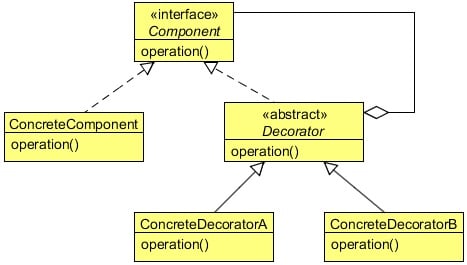Introduction
Decorator pattern allows a user to add new functionality to an existing object without altering its structure. This type of design pattern comes under structural pattern as this pattern acts as a wrapper to existing class. This pattern creates a decorator class which wraps the original class and provides additional functionality keeping class methods signature intact.
Intent
- Add additional responsibilities to an object dynamically. Decorators provide a flexible alternative to subclassing for extending functionality.
- Client-specified embellishment of a core object by recursively wrapping it.
- Use composition to extend the behaviour of an object and adhere to Open – Close principal.
Implementation
The participants classes in the decorator pattern are:
- Component – Interface for objects that can have responsibilities added to them dynamically.
- ConcreteComponent – Defines an object to which additional responsibilities can be added.
- Decorator – Maintains a reference to a Component object and defines an interface that conforms to Component’s interface.
- Concrete Decorators – Concrete Decorators extend the functionality of the component by adding state or adding behaviour.
Example
Following given example is an implementation of decorator design pattern. Icecream is a classic example for decorator design pattern. You create a basic icecream and then add toppings to it as you prefer. You can add as many topping as you want.
public interface Icecream {
public String makeIcecream();
}
public class SimpleIcecream implements Icecream {
@Override
public String makeIcecream() {
return "Base IceCream";
}
}
// Decorator
abstract class IcecreamDecorator implements Icecream {
protected Icecream iceCream;
public IcecreamDecorator(Icecream iceCream) {
this.iceCream = iceCream;
}
public String makeIcecream() {
return iceCream.makeIcecream();
}
}
// Class implementing decorator
public class NuttyDecorator extends IcecreamDecorator {
public NuttyDecorator(Icecream iceCream) {
super(iceCream);
}
public String makeIcecream() {
return iceCream.makeIcecream() + addNuts();
}
private String addNuts() {
return " + cruncy nuts";
}
}
public class HoneyDecorator extends IcecreamDecorator {
public HoneyDecorator(Icecream iceCream) {
super(iceCream);
}
public String makeIcecream() {
return iceCream.makeIcecream() + addHoney();
}
private String addHoney() {
return " + sweet honey";
}
}
public class TestDecorator {
public static void main(String args[]) {
Icecream icecream = new SimpleIcecream();
icecream = new NuttyDecorator(icecream);
icecream = new HoneyDecorator();
System.out.println(icecream.makeIcecream());
}
}Advantages
- Decorator pattern can be used to make it possible to extend (decorate) the functionality of a certain object at runtime.
- Decorator pattern is an alternative to subclassing. Subclassing adds behaviour at compile time, and the change affects all instances of the original class; decorating can provide new behaviour at runtime for individual objects
- Instead of trying to support all foreseeable features in a complex, customizable class, one can define a simple class and add functionality incrementally with Decorator objects.

